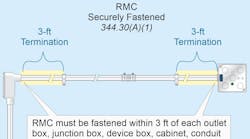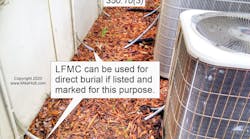All questions and answers are based on the 2014 NEC.
Q. What is a Class I hazardous (classified) location?
A. Locations are classified according to the properties of the flammable gases, flammable liquid-produced vapors, combustible liquid-produced vapors, combustible dusts, or fibers/flyings that may be present — and the likelihood that a flammable or combustible concentration will be present [500.5(A)]. Note: To reduce expensive equipment and expensive wiring methods, locate as much electrical equipment as possible in an unclassified location.
Each room, section, or area is considered individually in determining its classification. The same building/structure might contain both Class I, Div. 1 and Div. 2 locations, or Class II, Div. 1 and Div. 2 locations, or Class III, Div. 1 and Div. 2 locations.
A Class I location is an area where flammable gases, flammable liquid-produced vapors, or combustible liquid-produced vapors may be present in the air and in quantities sufficient to produce explosive or ignitible mixtures [500.5(B)]. An area where ignitible concentrations of flammable gases, flammable liquid-produced vapors, or combustible liquid-produced vapors may exist in the course of normal operations [500.5(A)(1)]:
• Continuously or periodically under normal operating conditions.
• Because of repair or maintenance operations or leakage.
• If faulty equipment releases ignitible concentrations of flammable gases, flammable liquid-produced vapors, or combustible liquid-produced vapors, and the equipment becomes a source of ignition.
Class I, Div. 1 locations include:
• Areas where volatile flammable liquids or liquefied flammable gases are transferred from one container to another, such as at gasoline storage and dispensing areas.
• Interiors of spray booths and in the vicinity of spraying and painting operations where volatile flammable solvents are used to coat products with paint or plastics.
• Locations containing open tanks or vats of volatile flammable liquids, or dip tanks for parts cleaning or other operations.
See 500.5(B)(3) Note 1 and 2 in the NEC for more information.
A Class I, Div. 2 location is an area where volatile flammable gases or vapors would become hazardous only in case of an accident or of some unusual operating condition — or under any of the following conditions [500.5(A)(2)]:
• If volatile flammable gases, flammable liquid-produced vapors, or combustible liquid-produced vapors are handled, processed, or used but are normally confined within closed containers and the gases would only escape in the case of accidental rupture or breakdown, or in case of abnormal operation of equipment.
• If ignitible concentrations of flammable gases, flammable liquid-produced vapors, or combustible liquid-produced vapors are normally prevented by positive mechanical ventilation but might become hazardous through failure or abnormal operation of the ventilating equipment.
• Areas adjacent to a Class I, Div. 1 location and to where flammable gases, flammable liquid-produced vapors, or combustible liquid-produced vapors might occasionally be communicated unless prevented by adequate positive-pressure ventilation with effective safeguards against ventilation failure.
Note 1: The quantity of volatile flammable gases, flammable liquid-produced vapors, or combustible liquid-produced vapors that might escape in case of accident, the adequacy of ventilating equipment, the total area involved, and the record of the industry with respect to explosions or fires are all factors that should be taken into consideration.
Q. What does the Code require in regard to mechanical strength and minimum size of overhead conductors?
A. Conductors 10 AWG and larger are permitted for overhead spans up to 50 ft long. For spans more than 50 ft in length, the minimum size conductor is 8 AWG, unless supported by a messenger wire [225.6(A)(1)].
Q. When a receptacle is installed to serve a specific appliance, what is the Code requirement regarding the location of the receptacle outlet?
A. Receptacle outlets installed in a dwelling unit for a specific appliance, such as a clothes washer, dryer, range, garage door opener, or refrigerator, must be within 6 ft of the intended location of the appliance [210.50(C)].
Q. What are the standard ampere ratings for overcurrent protection devices?
A. Section 240.6(A) of the Code lists standard ratings as:
The standard ratings in amperes for fuses and inverse time breakers are: 15, 20, 25, 30, 35, 40, 45, 50, 60, 70, 80, 90, 100, 110, 125, 150, 175, 200, 225, 250, 300, 350, 400, 450, 500, 600, 700, 800, 1,000, 1,200, 1,600, 2,000, 2,500, 3,000, 4,000, 5,000 and 6,000.
Additional standard ampere ratings for fuses include 1, 3, 6, 10, and 601.
Note: Fuses rated less than 15A are sometimes required for the protection of fractional horsepower motor circuits [430.52], motor control circuits [430.72], small transformers [450.3(B)], and remote-control circuit conductors [725.43].



